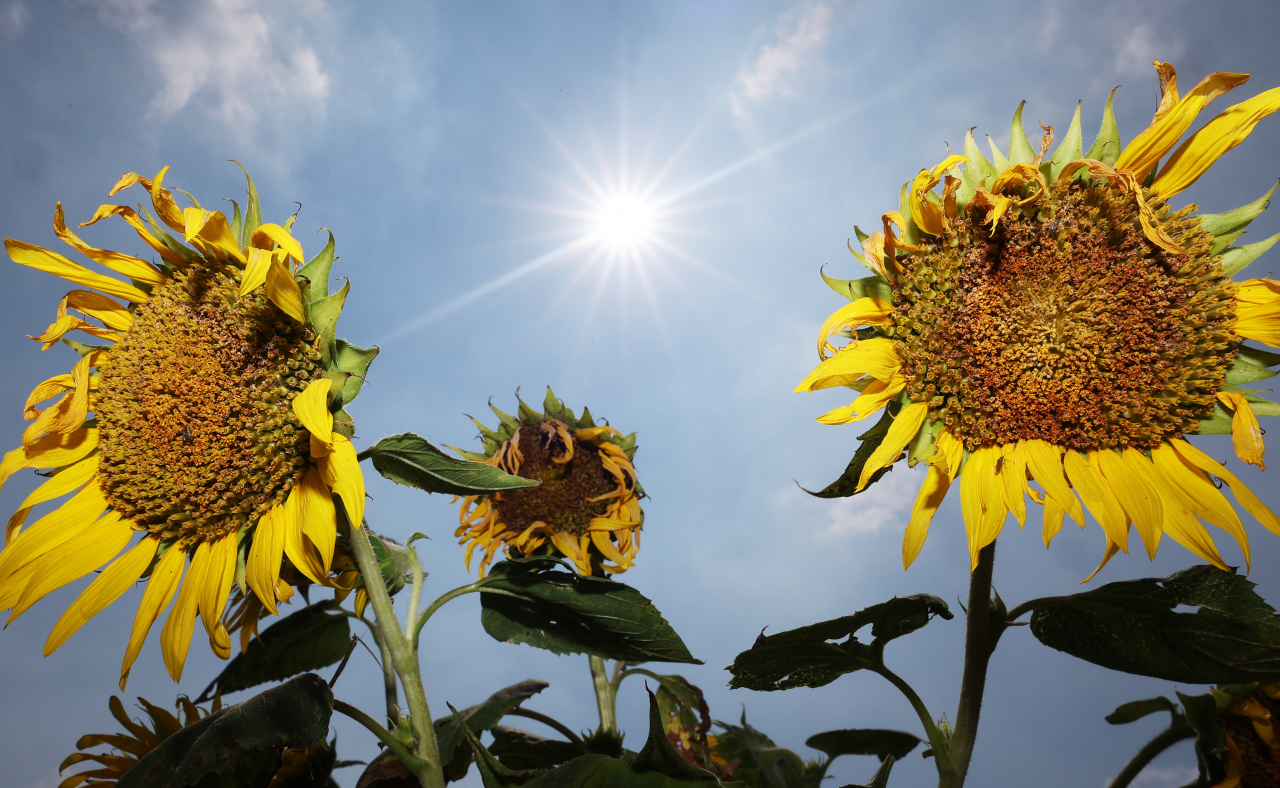 |
The sun shines strongly on dried-up sunflowers at a farm in Suwon, Gyeonggi Province on Sunday. (Yonhap) |
The number of patients admitted to emergency rooms with heat-related illnesses overnight increased by some 900 percent over the past decade, data by the Korea Disease Control and Prevention Agency showed Tuesday, amid growing concerns of an increase in tropical nights in recent years.
Since the establishment of the agency’s heat illness surveillance system in 2011, the number of patients admitted to emergency rooms between 12 a.m. -- the start of a new day -- and 10 a.m. jumped 923 percent from 30 in 2011 to 307 in 2023.
The data merges and takes into account two separate sets of data compiled by the KDCA: Between 6 a.m. and 10 a.m. the number of patients with heat-related illnesses jumped from 20 in 2011 to 265 in 2023; between 12 a.m. and 6 a.m., the corresponding figure increased from 10 to 42 in the decade-long period.
The KDCA added that the number of patients suffering heat-related illnesses in the afternoon also increased between 2011 and 2023. Between 12 p.m. and 7 p.m., the number of patients with heat-related illnesses increased from 330 patients to 1,788 patients in 2023, a 442 percent increase.
Previously, the KDCA warned the public of being in danger of heat-related illnesses during the daytime. However, with the number of patients with heat-related illnesses being admitted to hospitals after sundown increasing over the years, the agency advised that safety precautions, such as consistently drinking water and getting enough rest, be taken in the evening as well.
Regarding the increase in cases of heat-related illnesses overnight, the KDCA was found to cite the tropical night phenomena as one of the possible reasons in local media reports. Tropical nights refer to a phenomenon where the lowest temperature remains above 25 degrees Celsius until the next day.
Recently, a number of major cities in South Korea have experienced consistent tropical nights. As of Tuesday, Gangneung in Gangwon Province has seen 18 consecutive tropical nights since July 19, the longest number of tropical nights recorded in 113 years. Other cities such as Seoul has seen tropical nights occur for 16 consecutive days, while Jeju Island saw tropical nights occur for 22 consecutive days.
As the tropical night phenomena and scorching heat continues to persist for more than 10 days in most parts of the country, Prime Minister Han Duck-soo wrote on his Facebook account Tuesday that the government will put its “utmost efforts” into minimizing the impacts of Korea’s recent high temperatures.
“Though the government is scrambling to implement measures to deal with the recent heat, my heart feels heavy as several lives have been affected due to heat-related illnesses this weekend alone,” wrote Han. “Until the heat wave subsides, the government will do everything in its power to minimize the damages that could come with the heat.”
According to the KDCA, 1,546 cases of heat-related illnesses have been reported as of Saturday, with 154 cases on Saturday alone. Following the consistent surge in patients with heat-related illnesses and temperatures being above 35 C, the Interior Ministry has also maintained its heat wave response level on “serious,” the highest within its four-tier system, since July 31.







![[Today’s K-pop] Blackpink’s Jennie, Lisa invited to Coachella as solo acts](http://res.heraldm.com/phpwas/restmb_idxmake.php?idx=644&simg=/content/image/2024/11/21/20241121050099_0.jpg)